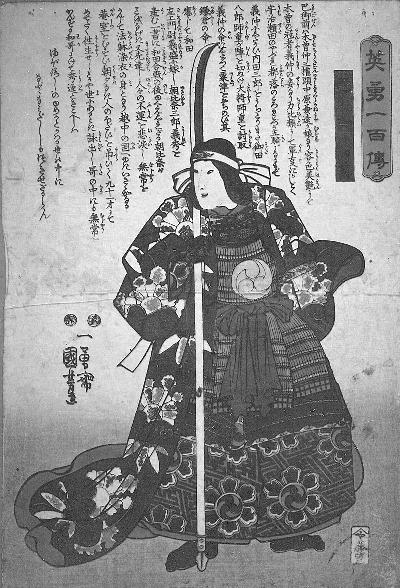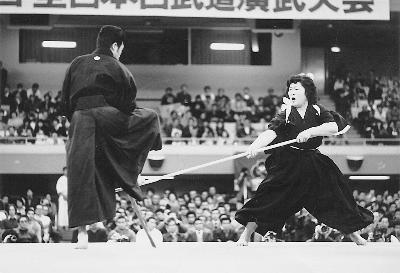- Introduction
- Early History
- The Warring States Period
- The Edo Period: An Enforced Peace
- Tendo Ryu: One foot on the Battlefield, One in the Modern World
- Jikishin Kage Ryu Naginata-do and the Development of Meiji Budo
- The Birth of Modern Competitive Martial Sports
- Women’s Martial Training in Modern Times
- Conclusion
- Bibliography
Introduction
The entry of Asian martial arts into the Western world has happened to coincide, through no particular design, with the transformation of women’s role in society. Women of the late twentieth century have risen into prominence in business, science, and as players on the political stage. The victimization of women in domestic violence and sexual and physical assault is still rampant, but it is increasingly countered through legislation and political activism and, on a personal level, through women’s pursuit of fighting skills to defend themselves. Ever greater numbers of women are involved in martial arts and self-defense training.
For most people, identifying with one’s predecessors is a strong desire. One often models oneself on an ideal that is personified in heroic myths or tales. For many women interested in Japanese martial practice, there is the image of the woman warrior bearing a naginata in the protection of her home and even on the field of battle. Although it is a glorious image, it is difficult to separate fact from fancy because of the almost complete absence of historical records that document the role of arms-bearing women.
Early History
The battle tales of Japan, chronicles of wars in the Heian, Kamakura, and Muromachi periods, focus almost completely on the deeds of the nobility and warrior classes. These tales, passed down by blind bards much as Homer’s Iliad, present warriors as archetypes: the tragic Loser-Hero, the Warrior-Courtier, the Traitor, the Coward, etc. Women warriors are almost never described or even mentioned.
Women’s roles in such tales are slight: the Tragic Heroine who kills herself at the death of her husband; the Loyal Wife who is taken captive; the Stalwart Mother who grooms her son to take vengeance for his father’s death; the Merciful Woman whose “weak” and “feminine” qualities encourage a warrior chieftain to indulge in unmanly empathy and dissuade him from slaughtering his enemy’s children, who later grow up to kill him; and the Seductress who preoccupies the warrior leader and diverts him from his task with her feminine wiles. Finally, almost casually mentioned, are women en masse: either slaughtered or “given” to the warriors as “spoils-of-war.” That they were surely raped and often murdered was apparently considered too trivial a fact to even mention in later warrior tales once the conventions of the genre had been codified, just as the wholesale burning and pillaging of peasants’ farms was considered such a matter of course that it ceased to be mentioned, as if such repeated references would only disturb the flow of narrative. Unless one is willing to imagine a conspiracy of silence in which women’s role on the battlefield was suppressed in both historical records and battle-tales, it is a fair assumption that onna-musha (women warriors) were very unusual. This is borne out, I believe, by the prominence given to the few women about whom accounts are written. The most famous women warriors are Tomoe Gozen and Hangaku Gozen (sometimes called Itagaki). Interestingly, for both of these women the naginata was not their weapon of choice.

In the Heike Monogatari, Tomoe Gozen appears as a general in the troops of Kiso Yoshinaka, Yoritomo’s first attack force. She was described as follows:
Tomoe was especially beautiful, with white skin, long hair, and charming features. She was also a remarkably strong archer, and as a swordswoman she was a warrior worth a thousand, ready to confront a demon or a god, mounted or on foot. She handled unbroken horses with superb skill; she rode unscathed down perilous descents. Whenever a battle was imminent, Yoshinaka sent her out as his first captain, equipped with strong armor, an oversized sword, and a mighty bow; and she performed more deeds of valor than any of his other warriors.
—Tale of the Heike1
Her last act, on the verge of Yoshinaka’s defeat, is the subject of many plays and poems. To buy time for her husband to commit seppuku, she rode into the enemy forces and, flinging herself on their strongest warrior, unhorsed, pinned, and decapitated him. In the interim, however, Yoshinaka was killed by an arrow. There are legends that she was killed, and others that she survived to become a Buddhist nun. There is also a legend that she was taken captive by Wada Yoshimori and had a son, Asahina, considered to be the strongest warrior of the later Kamakura era.
However, Tomoe has not ever been proven to be an historical figure–and this was not for lack of trying. She has exerted a fascination upon the Japanese for hundreds of years in the startling image of a beauteous woman who was also a breaker of wild horses and the equal of any man. Tomoe is claimed by more than a few naginata traditions to be either their founder or one of their primordial teachers. There is, however, no historical justification for such claims. She lived centuries before their martial traditions were even dreamed of.
The second famous woman warrior is Hangaku Gozen, daughter of the Jo, a warrior family of Echigo province. She was known for her strength and accuracy with the bow and arrow. In 1201, after the feudal government attempted to subjugate one of her nephews, the warriors of Echigo and Shinano revolted. Besieged in Tossaka castle, she held off the enemy from the roof of a storehouse. After being wounded in both legs by spears and arrows, she was taken prisoner and presented before the Shogun Yoriie. Drawn by her beauty and dignity, Yoshito Asari of the Kai Genji courted her and they married. The stories do not say if this union was coerced or a match of equals. According to one account, they lived the rest of their lives in peace, but in another account, she was killed while assisting in the defense of Torizakayama Castle.
Thus, at least in the earlier periods such as the Heian and Kamakura, women who became prominent or even present on the field of battle were the exception rather than the rule. This does not indicate, however, that most women were powerless. There is a common image of Japanese femininity based on the accounts we have of women of the Imperial Court, swaddled in layers of kimono and rigid custom, preoccupied with poetry and moon viewing. But such a picture obscures just who the bushi women were during the ascendancy of their class. They were originally pioneers, helping to settle new lands and, if need be, fighting, like women of the old western territories in American history. Some bushi clans may even have been led by women. This can be inferred from the legal right given to women to function as jito (stewards), who supervised land held in absentia by nobles or temples.

Bushi women were trained mainly with the naginata because of its versatility against all manner of enemies and weapons. It was generally the responsibility of women to protect their homes rather than go off to battle, so it was important that they become skilled in a few weapons that offered the best range of techniques to defend against marauders who often attacked on horseback. Therefore, it makes sense that women were sometimes adept with the bow due to its effectiveness at long-range and often with the naginata as it was an effective weapon against horse riders at closer range. In addition, most women are weakest at close quarters where men can bring their greater weight and strength to bear. A strong, lithe woman armed with a naginata could keep all but the best warriors at a distance, where the advantages of strength, weight, or sword counted for less.
Copyright ©2002 Ellis Amdur. All rights reserved.
[Part 1 | Part 2 | Part 3 | Part 4 | Part 5]
This article first appeared in Journal of Asian Martial Arts, vol. 5, no. 2, 1996. It has been extensively revised for inclusion in Old School: Essays on Japanese Martial Traditions.
- McCullough, Helen Craig, trans., The Tale of the Heike, Stanford University Press, California, 1988. (For this and all further references to Tomoe Gozen.) ↩︎
